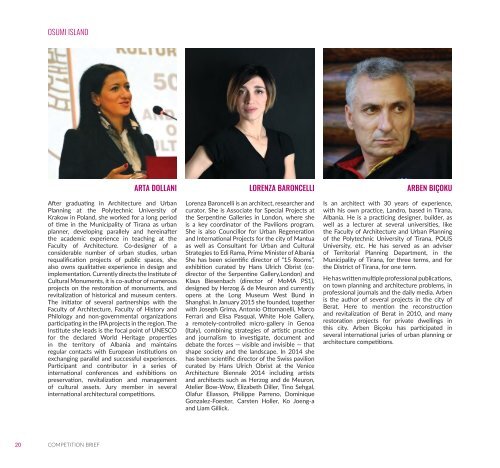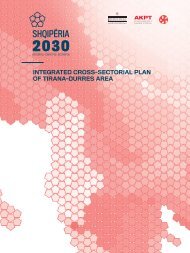Osumi Island
This competition is based on a test site and is looking for ways of making places resilient. It is using design as a tool to search for best possible solutions of resilience in riverside conditions. It is also looking for ways of developing natural landscapes and defining ‘urban by nature’. Being a test site, it means that the findings of the process can be shared with many other similar context or sites that are at a flooding risk zone and lack features of being resilient. In this perspective, this exercise serves more than the city of Berat. The proposals might become an inspirational source for other sites in Albania or beyond its borders.
This competition is based on a test site and is looking for ways of making places resilient. It is using design as a tool to search for best possible solutions of resilience in riverside conditions. It is also looking for ways of developing natural landscapes and defining ‘urban by nature’. Being a test site, it means that the findings of the process can be shared with many other similar context or sites that are at a flooding risk zone and lack features of being resilient. In this perspective, this exercise serves more than the city of Berat. The proposals might become an inspirational source for other sites in Albania or beyond its borders.
You also want an ePaper? Increase the reach of your titles
YUMPU automatically turns print PDFs into web optimized ePapers that Google loves.
<strong>Osumi</strong> ISLAND<br />
ARTA DOLLANI<br />
After graduating in Architecture and Urban<br />
Planning at the Polytechnic University of<br />
Krakow in Poland, she worked for a long period<br />
of time in the Municipality of Tirana as urban<br />
planner, developing parallely and hereinafter<br />
the academic experience in teaching at the<br />
Faculty of Architecture. Co-designer of a<br />
considerable number of urban studies, urban<br />
requalification projects of public spaces, she<br />
also owns qualitative experience in design and<br />
implementation. Currently directs the Institute of<br />
Cultural Monuments, it is co-author of numerous<br />
projects on the restoration of monuments, and<br />
revitalization of historical and museum centers.<br />
The initiator of several partnerships with the<br />
Faculty of Architecture, Faculty of History and<br />
Philology and non-governmental organizations<br />
participating in the IPA projects in the region. The<br />
Institute she leads is the focal point of UNESCO<br />
for the declared World Heritage properties<br />
in the territory of Albania and maintains<br />
regular contacts with European institutions on<br />
exchanging parallel and successful experiences.<br />
Participant and contributor in a series of<br />
international conferences and exhibitions on<br />
preservation, revitalization and management<br />
of cultural assets. Jury member in several<br />
international architectural competitions.<br />
LORENZA BARONCELLI<br />
Lorenza Baroncelli is an architect, researcher and<br />
curator. She is Associate for Special Projects at<br />
the Serpentine Galleries in London, where she<br />
is a key coordinator of the Pavilions program.<br />
She is also Councillor for Urban Regeneration<br />
and International Projects for the city of Mantua<br />
as well as Consultant for Urban and Cultural<br />
Strategies to Edi Rama, Prime Minister of Albania<br />
She has been scientific director of “15 Rooms”,<br />
exhibition curated by Hans Ulrich Obrist (codirector<br />
of the Serpentine Gallery,London) and<br />
Klaus Biesenbach (director of MoMA PS1),<br />
designed by Herzog & de Meuron and currently<br />
opens at the Long Museum West Bund in<br />
Shanghai. In January 2015 she founded, together<br />
with Joseph Grima, Antonio Ottomanelli, Marco<br />
Ferrari and Elisa Pasqual, White Hole Gallery,<br />
a remotely-controlled micro-gallery in Genoa<br />
(Italy), combining strategies of artistic practice<br />
and journalism to investigate, document and<br />
debate the forces — visible and invisible — that<br />
shape society and the landscape. In 2014 she<br />
has been scientific director of the Swiss pavilion<br />
curated by Hans Ulrich Obrist at the Venice<br />
Architecture Biennale 2014 including artists<br />
and architects such as Herzog and de Meuron,<br />
Atelier Bow-Wow, Elizabeth Diller, Tino Sehgal,<br />
Olafur Eliasson, Philippe Parreno, Dominique<br />
Gonzalez-Foester, Carsten Holler, Ko Joeng-a<br />
and Liam Gillick.<br />
ARBEN BIÇOKU<br />
Is an architect with 30 years of experience,<br />
with his own practice, Landro, based in Tirana,<br />
Albania. He is a practicing designer, builder, as<br />
well as a lecturer at several universities, like<br />
the Faculty of Architecture and Urban Planning<br />
of the Polytechnic University of Tirana, POLIS<br />
University, etc. He has served as an adviser<br />
of Territorial Planning Department, in the<br />
Municipality of Tirana, for three terms, and for<br />
the District of Tirana, for one term.<br />
He has written multiple professional publications,<br />
on town planning and architecture problems, in<br />
professional journals and the daily media. Arben<br />
is the author of several projects in the city of<br />
Berat. Here to mention the reconstruction<br />
and revitalization of Berat in 2010, and many<br />
restoration projects for private dwellings in<br />
this city. Arben Biçoku has participated in<br />
several international juries of urban planning or<br />
architecture competitions.<br />
20<br />
Competition brief
















